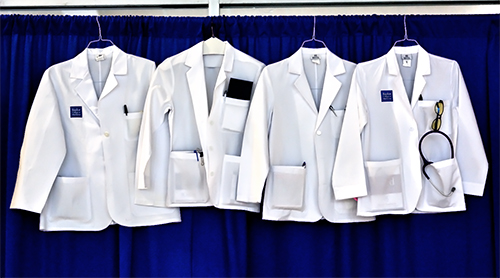From Pre-Med to Med: Making the Transition to Medical School
 Making the transition from college to medical school is one of the biggest academic “leaps” a student can make. I was recently asked to address the Texas Association of Advisors for the Health Professions on how to best advise students getting ready to start medical school.
Making the transition from college to medical school is one of the biggest academic “leaps” a student can make. I was recently asked to address the Texas Association of Advisors for the Health Professions on how to best advise students getting ready to start medical school.
There are more details in the slides I presented (Here’s a link to the slides:Transition to medical school), but the following are the “top ten” pieces of advice I passed on during my lecture:
- Arrive a week early (at least). It’s important to build in time to move into your new home and make it a space you enjoy. Make sure your electricity and cable are working. Meet your neighbors, find a gym, stock your kitchen with healthy food. It’s tempting to stay with your family (or add to your trip to Europe), but don’t – the time you spend getting ready to start medical is time well invested.
- Buy a good computer (and the appropriate software). Check on line to see if your school has specific requirements and make sure you meet them. You’ll want a laptop, not a desk computer – you’ll be taking notes in class and carrying your computer around to study. You’ll also be taking National Board exams on your own computer. Most medical students at Baylor organize their notes with One Note (PC) or Growly (Apple). You might want to buy the software and get used to it before you start.
- Set up your study space before the first day of class. You’ll be studying hard from the first day, so don’t put this off. Most students buy two monitors and hook their laptop to the monitors to study (usually with a supplemental keyboard and mouse, but this is optional). Buy a really good chair for your desk. If you listen to music while you study, invest in good speakers for your computer. Keep your desk organized. Put some reminders on your desk of why you are doing this for the times it’s not so easy. Consider a standing, walking or biking desk for your primary desk – or as a alternate desk.
- Learn about active study skills and apply them from day one. Your study style in medical school will be different than what you used in college. You have to learn all the material, as in really learn it. It all builds on itself, so you can’t skip parts that aren’t interesting. You’ll never cram for another test in your life – it’s all about learning, reviewing and repeating. To get ready, learn about methods like the SQR3 method of studying as well as other systems.
- Go to class (and be really present). Unlike college you’ll need to use class time as active learning time. Review the notes before the lecture and make notes during class. Ask for clarification during class. Most medical schools record the lectures as streaming video so you can review them later. It might be tempting to skip going to class but don’t. It’s easier to stay actively engaged if you are in class. You’ll be able to ask questions about the things you don’t understand. And, most importantly, if you don’t go to class you’ll miss out on the social benefits of being with your classmates.
- Start with studying 1 hour for every hour of class. Adjust up if needed. The amount of material you cover in a semester of medical school is the equivalent of 30+ hours of undergraduate courses. Medical school as a 60 hour a week job. Schedule your “work” on a calendar to make sure you make your 60 hours. When you tackle your hours of studying, use “study reps” – 45-50 minutes of all out studying followed by 10-15 minutes of absolutely no studying.
- Exercise at least 30 minutes every day. The real goal should be an hour a day, butthe minimum should be 30 minutes. You can “multitask” by riding your bike or walking to school. Daily exercise is a great way to decrease stress, help prevent future work related injury and prevent the medical school equivalent of the “freshman 10”.
- Plan your day so you can sleep 8 hours a night. No sleep = poor synapse formation. Poor synapse formation = no learning. It’s that simple. Don’t believe yourself or anyone else who says they “don’t need” 8 hours of sleep. It’s just not true.
- Eat real food. Good fuel is necessary for your brain to make the synapses that are necessary for learning. Eat well and often enough (every 4-6 hours) to keep you blood glucose stable. Shop on the outside of the store (where they real food is) and learn to cook! If you don’t cook, at least make conscious choices to buy prepared food that is healthy.
- Make friends and work to maintain those friendships. Social connections are one of the strongest antidotes to the stress of medical school. Make friends among your classmates (because they really understand what you are going through) and maintain your friendships out of medical school (for the perspective they will give you). Your significant other is your most important friend – so pay special attention to the time and effort you put in to supporting him/her.
–By Dr. Mary L. Brandt, professor of pediatrics, surgery. This story originally appeared on Dr. Brandt’s blog Wellness Rounds.




A must read for everyone who considers taking up medicine. Brilliantly put. Sums up a major part of what med school would be in a few words. Similar to a required prior experience even before getting there.